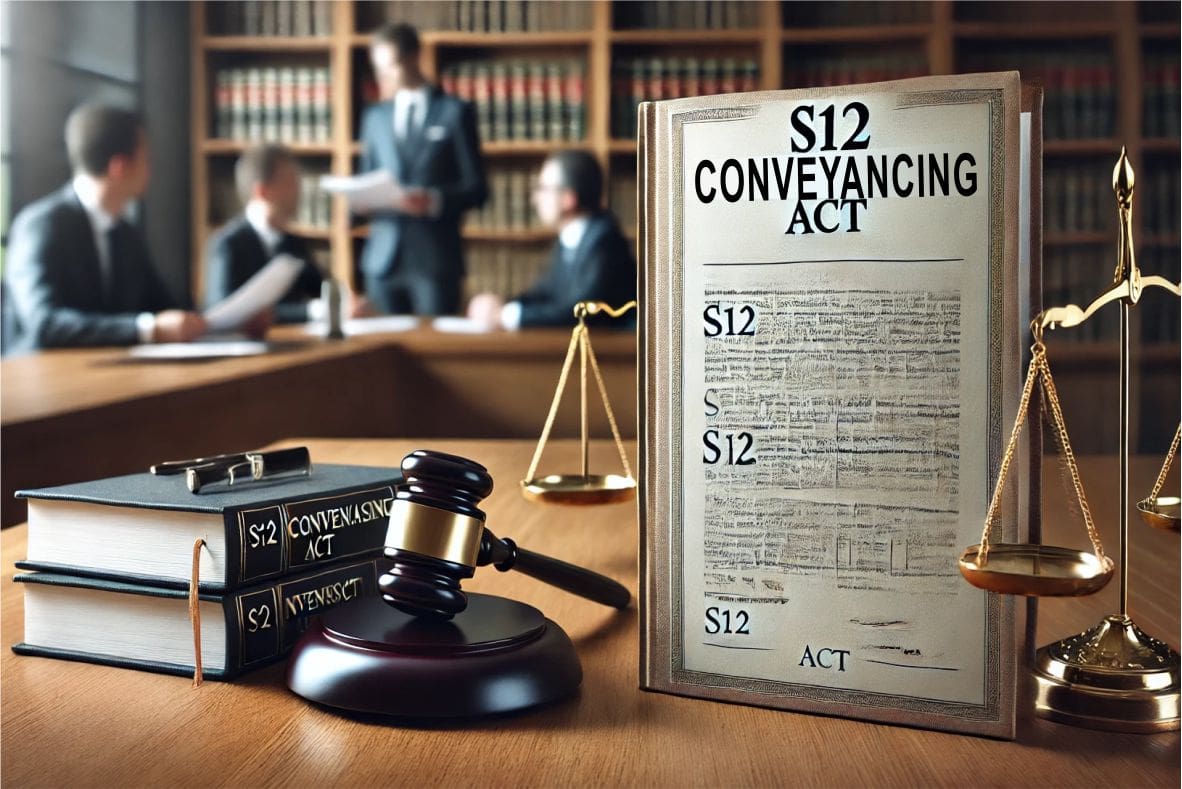S12 Conveyancing Act is a critical piece of legislation that regulates property transfers in many areas. If you’re involved in real estate deals, understanding the ins and outs of S12 is a must.
This article will walk you through all the important details of this statute, from breaking down what qualifies as a conveyance to the repercussions of not meeting the time limit set by S12. Keep reading so you’re on the ball and following the rules of S12 of the Conveyancing Act.
What is the S12 Conveyancing Act?
When dealing with real estate transactions, you’ll quickly realize how important the S12 Conveyancing Act is in property law. This Act takes the wheel in overseeing the conveyancing process, making sure all legal documents linked to property transfers are handled correctly.
Think of the S12 Conveyancing Act as the rulebook for property transactions. It lays out the rights and duties of buyers and sellers, carving out a clear path for everyone involved. From how property searches are done to drawing up contracts and ensuring titles are crystal clear, this Act sets the stage for a smooth ownership transfer.
By giving the lowdown on property disclosures, easements, and encumbrances, the goal of the S12 Conveyancing Act is to simplify the conveyancing process, minimize the risk of conflicts, and protect the interests of everyone in the real estate game.
What Does S12 of the Conveyancing Act Cover?
To transfer property, you need to know about Section 12 of the Conveyancing Act. This section deals with the legal aspects of property transfer, such as confirming land ownership, safeguarding legal rights, and correctly recording title deeds.
What is the Purpose of S12 of the Conveyancing Act?

The purpose of S12 of the Conveyancing Act is to provide a statutory framework that regulates land transfer, ensuring that all transactions are conducted fairly and legally. By setting out specific requirements and guidelines for property transfers, S12 plays an important role in safeguarding the rights of buyers and sellers involved in real estate transactions.
This provision outlines the necessary steps and documentation needed for a valid land transfer, thereby reducing the potential for disputes and ensuring clarity in property ownership. It promotes transparency and accountability in the conveyancing process, instilling greater confidence in the integrity of property transactions.
Ultimately, S12 contributes significantly to maintaining a robust and trustworthy legal framework for land transfer, upholding the fundamental principles of fairness and legality in property dealings.
What are the Key Provisions of S12 of the Conveyancing Act?
If you’re diving into the world of real estate transactions, you’ll want to pay attention to the key provisions of S12 of the Conveyancing Act. Outline the legislative requirements for things like the contract of sale and the procedures for property settlement.
What is the Definition of a ‘Conveyance’ under S12?
In S12, “”conveyance“” is all about transferring property ownership from one party to another through a legal process.
It’s a series of steps that make sure ownership rights shift smoothly, starting with drafting and signing a formal agreement between the parties. This contract usually covers property details, sale price, and transfer terms.
After that, a detailed review of any liens, encumbrances, or legal concerns tied to the property is carried out to guarantee a clean title transfer. Registering the transfer deed is an important part of the conveyance process as it officially records the ownership change.
What is the Importance of the Time Limit Set by S12?
The time limit set by S12 is important for making sure that property transactions are completed within a specific period, helping to meet legal obligations and making the settlement agent’s job easier.
You need to realize that this time limit is there to prevent any delays or uncertainties in property transactions. With a set timeframe, you, as the buyer and the seller, have to stick to your legal duties promptly, ensuring a smooth and effective transaction process.
Your settlement agent is super important in ensuring all obligations are met and all the necessary paperwork and funds are taken care of within the given time frame. This close attention to detail helps avoid any potential problems and conflicts, building trust and transparency in property transactions.
What Happens if the Time Limit is Not Met?
If you miss the time limit set by S12 of the Conveyancing Act, you could face some serious legal troubles. This might include property disputes cropping up and legal proceedings kicking into gear.
Not meeting the time limit could cause the contract to be voided, sparking uncertainties and disagreements over who really owns the property. This could set off a whole mess where sides end up in court to defend their rights. To steer clear of unnecessary legal drama and guarantee a smooth property transfer, everyone involved needs to stick to the timeline meticulously.
What are the Exceptions to the Time Limit Set by S12?
You might come across some exceptions to the time limit set by S12 of the Conveyancing Act. Exceptions are outlined within the statutory provisions to make room for certain circumstances within the legal framework.

What is the Role of the Registrar-General in Exceptions to S12?
Regarding managing exceptions to the time limit set by S12, the Registrar-General is your go-to person. They oversee all the legal stuff and make sure land registration is done right in those cases.
If you find yourself with a valid reason for missing that time limit, the ball is in the Registrar-General’s court. They carefully review and approve special cases by checking out all the details and making sure everything follows the legal rules. Getting land registered in exceptional situations is super important for protecting property rights and keeping ownership transfers transparent. The Registrar-General’s job is all about making sure the land registration system stays legit and the rule of law is upheld when things get tricky.
What is the Process for Applying for an Exception to S12?
When you’re looking to apply for an exception to S12, you’ll need to navigate through a series of legal procedures that must be followed meticulously to make sure you’re in line with property conveyancing regulations.
What Documentation is Required for an Exception to S12?
When you’re seeking an exception to S12, you’ll need to gather specific documentation, like legal papers that lay out a detailed explanation of the unique circumstances involved in the conveyancing process.
Legal papers usually include a thorough breakdown of the situation, along with evidence that supports why the exception is necessary and how it lines up with the relevant statutes. You might also have to provide financial records to show the economic impact of needing the exception. Understanding the legal framework behind requirements is key – it’s all about keeping things transparent and fair when reviewing exception requests.
Making sure your documentation is comprehensive and accurate is important to back up why the exception is needed and help the approval process run smoothly. This reduces the chance of delays or misunderstandings and guarantees that your application is evaluated fairly and efficiently.
How Long Does the Process Take?
When you’re applying for an exception to S12, the timeline varies depending on how complicated the legal procedures are and the specifics of the property transfer you’re dealing with.
For example, if there’s a lot of documentation and multiple parties involved in the legal procedures, it’s going to take more time. And whether it’s a commercial real estate transfer or a residential one will also affect how long it all takes.
Normally, the whole process – from when you submit your application to when you get a decision – take anywhere from a few weeks to a couple of months. How fast the reviewing authorities work and if there are any appeals thrown into the mix also play a part in how long it all takes.
What are the Consequences of Not Complying with S12?
If you don’t follow S12 of the Conveyancing Act, you could be in for some trouble. Legal action and hefty penalties might come knocking, causing a real headache for your property transactions.
What Legal Action Be Taken?
If you don’t follow S12, you might find yourself in some legal hot water. Legal action could be taken against you, leading to property disputes and a bunch of legal rigamarole to sort things out.
You could end up in the middle of a civil lawsuit, where the other party involved might sue you to get compensation or make you comply with the rules. If things get really messy, you might have to try out mediation or arbitration to work things out without hitting the courtroom.
Property disputes bubble up because of boundary disagreements, easement clashes, or ownership squabbles, all of which might need legal help to figure out who owns what and settle the score. Legal procedures in situations often involve gathering evidence, making arguments in front of a judge, and finally getting a legally binding decision to put the matter to rest.
What are the Potential Penalties?
When you don’t comply with S12, you’re playing with fire. The consequences seriously mess with property transactions and put you in a legal bind.
You could be looking at some pretty hefty fines or even getting your license suspended or yanked, depending on how bad the violation is. On top of that, non-compliance throw a wrench into your property deals, causing delays and even sparking legal battles between buyers and sellers. Make sure everyone involved knows the rules inside and out to sidestep penalties and dodge the fallout on your property transactions.
How One Ensure Compliance with S12 of the Conveyancing Act?
Making sure you comply with S12 of the Conveyancing Act means you need to meet legal obligations, make the most of a property conveyancer, and carefully handle property transactions.
What Steps Should Be Taken to Meet the Time Limit?
To meet the time limit set by S12, you need to follow specific steps, adhere to legal procedures, and make sure all property agreements are completed on time.
You have to carefully review the requirements outlined in S12 and break down the process into smaller achievable tasks. Make sure to follow legal procedures meticulously to avoid any delays or complications. Efficiently managing property agreements requires clear communication with everyone involved and ensuring all necessary documentation is in order. Stay organized and proactive in addressing any issues promptly to maintain compliance and effectively meet the time limit.
What are Some Common Mistakes to Avoid?
Common mistakes you might make when meeting the time limit set by S12 include failing to seek legal advice, mismanaging property transactions, and missing critical deadlines.
It’s important for you to understand the importance of seeking legal advice in property transactions. This ensures you comply with regulations and steer clear of potential pitfalls. If you skip consulting with a legal professional, you might unintentionally overlook important legal aspects, which leads to costly errors. Poor management of property transactions causes delays, disputes, or even legal troubles.
Make sure you stick to deadlines because missing them results in penalties, completion delays, or even putting the entire transaction at risk. That’s why it’s necessary for you to stay organized, seek guidance, and make timeliness a priority to navigate property transactions successfully.
5-Sentence Summary about S12 Conveyancing Act
The S12 Conveyancing Act is the key legislation for regulating property transfers. Understanding this statute is essential for anyone involved in real estate deals. It outlines the legal steps needed to confirm land ownership, protect legal rights, and record title deeds correctly.
S12 sets a clear framework for property transactions, ensuring all parties follow specific guidelines. It covers property searches, contract preparations, and title transfers, aiming to reduce conflicts and protect everyone involved. Missing the time limits set by S12 can lead to legal troubles, disputes, and voided contracts, emphasizing the importance of compliance. For exceptions, the Registrar-General oversees and approves cases, ensuring transparency and legality.
Frequently Asked Questions
What is S12 Conveyancing Act?
S12 Conveyancing Act refers to section 12 of the Conveyancing Act, which outlines the requirements for executing a deed in New South Wales, Australia.
What is the purpose of S12 Conveyancing Act?
The purpose of S12 Conveyancing Act is to ensure that deeds are properly executed and legally binding by specifying the necessary elements that must be present.
What are the requirements for executing a deed under S12 Conveyancing Act?
According to S12 Conveyancing Act, a deed must be in writing, signed by the party making it, and witnessed by at least two witnesses who are not parties to the deed.
What happens if the requirements of S12 Conveyancing Act are not met?
If the requirements of S12 Conveyancing Act are not met, the deed may be deemed invalid and unenforceable in a court of law.
Does S12 Conveyancing Act apply to all types of deeds?
Yes, S12 Conveyancing Act applies to all types of deeds, including deeds of transfer, mortgage, and lease.
Are there any exceptions to the requirements of S12 Conveyancing Act?
There are some exceptions to the requirements of S12 Conveyancing Act, such as in cases where the deed is made by a company or for a specific type of property, such as a ship or aircraft.
Get your quote today.
Relax knowing our experts are handling your property conveyancing.









